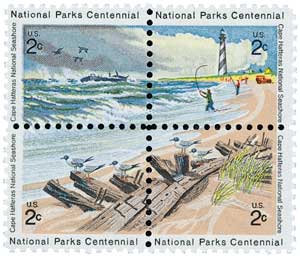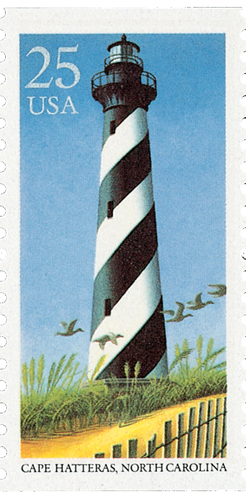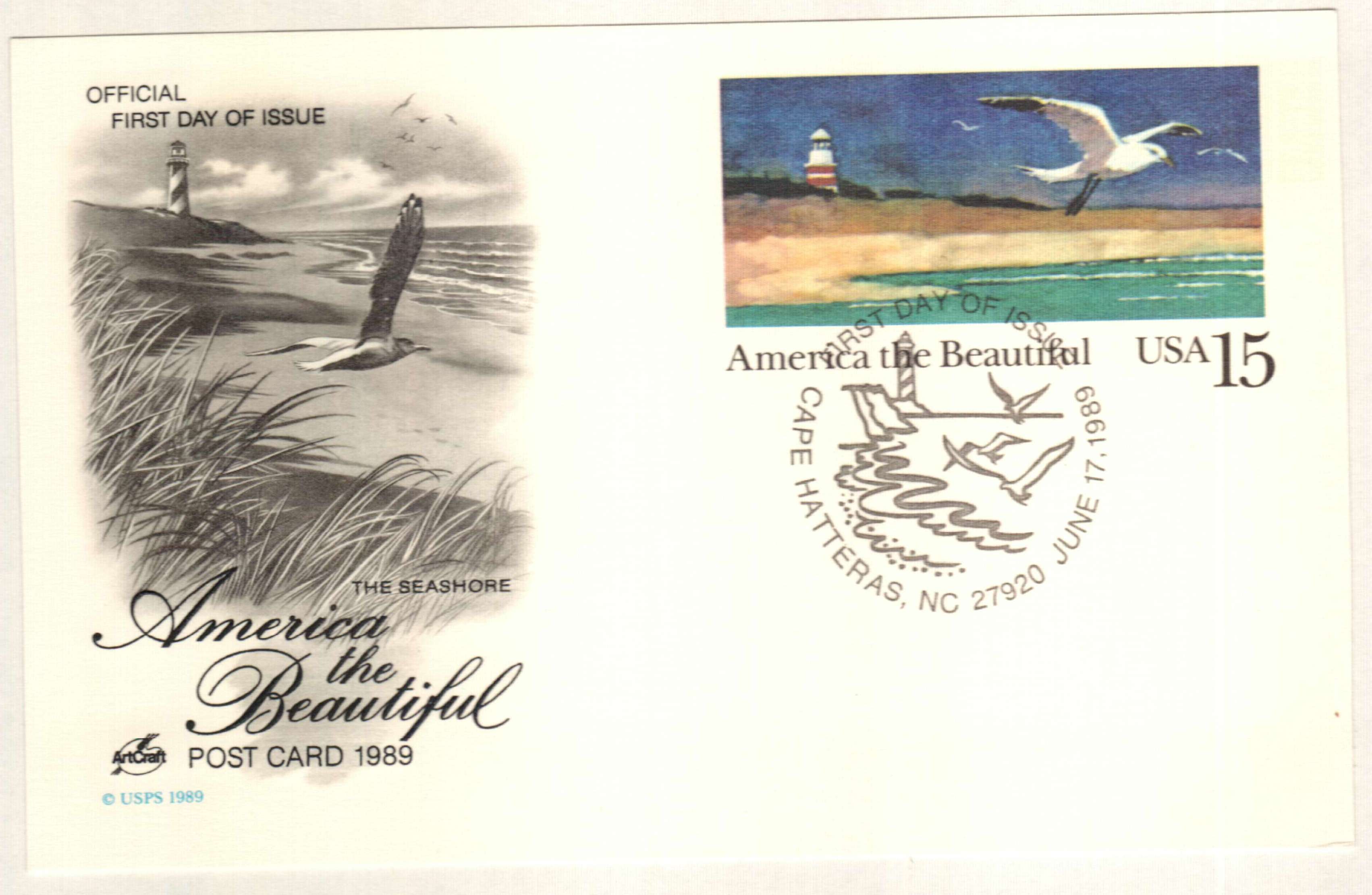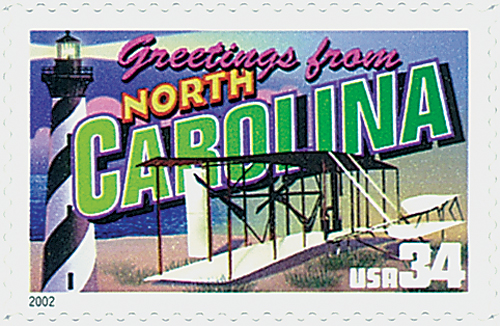
# UX132 - 1989 15c Postal Card - The Seashore
Â
On January 12, 1953, Cape Hatteras became America’s first national seashore. Stretched over 70 miles of barrier islands, this seashore is a fascinating combination of natural and cultural resources. Cape Hatteras National Seashore lies on the wind swept Outer Banks of North Carolina, surrounded by the Atlantic Ocean and Pamlico Sound. Native Americans first settled along the seashore about AD 500. Because they were several miles offshore, they lived in peace for over 1,000 years, without threat of invading tribes. In 1524, Spanish explorer Giovanni Da Verrazzano landed near the Hatteras Island and reported meeting friendly natives. The island first appeared on a European map in 1585 as “Hatterask,†after the Hatteras tribe that lived on the island. Some historians believe that the people from the lost colony of Roanoke may have moved to Hatteras Island to escape hostile tribes. They cite reports of unusual blue-eyed natives on the island as well as the discovery of a 16th century English ring. Cape Hatteras is located at a key point in the coastline of North America. It’s where the coast running southwest meets the coast running northeast and ocean currents collide. The result is an area with dangerous sandbars and frequent ocean storms. The dangerous conditions have caused so many ships to be lost (more than 600), that it’s been nicknamed the “Graveyard of the Atlantic.â€Â This led the new US government to approve the building of a lighthouse. Completed in 1803, the 90-foot lighthouse failed to provide sufficient light. Fifty years later, the lighthouse was made 60 feet taller, and a brighter light was installed. The island was the site of the Civil War Battle of Hatteras Inlet in August 1861. Union forces gained control and it became a safe place for freed and runaway slaves. The storms of Cape Hatteras claimed a well-known prize on New Year’s Eve, 1862. The USS Monitor – one of the first ironclad ships – was being towed around Hatteras since it was poorly equipped for ocean travel. The high waves of a heavy storm swamped the ship, sending it to its doom. A new lighthouse was constructed in 1870. Standing 208 feet tall, it’s the tallest brick lighthouse in the country. The lighthouse is well known for its distinctive candy-cane-like black and white stripes. In the early 1900s, tourists began to flock to the island. By the 1930s, calls were made to protect the area, which was an important breeding ground for many animal species including the loggerhead sea turtle. The area was transferred to the National Park Service in 1937. Philanthropist Paul Mellon donated funds to purchase much of the land for the park. During World War II, the waters off the Outer Banks became known as “Torpedo Junction.â€Â In early 1942, German U-boats launched Operation Drumroll, sinking 397 merchant ships over the course of just six months. The US response was slow, but eventually destroyers and patrol planes were brought in, drastically reducing the number of German attacks. More than a decade after the war, Cape Hatteras was officially established as America’s first national seashore on January 12, 1953, and was dedicated on April 24, 1958. Over the years, the Cape Hatteras Lighthouse was threatened by encroachment from the sea. To save the lighthouse it was moved 1,600 feet away from the Atlantic Ocean in 1999. The National Park Service reported that after more than a year, the tower had not shifted by any measurable degree and is considered entirely stable. Today, the park preserves important animal habitats and welcomes tourists. Its fishing and surfing are considered by some to be the best on the east coast.Cape Hatteras National Seashore









Â
On January 12, 1953, Cape Hatteras became America’s first national seashore. Stretched over 70 miles of barrier islands, this seashore is a fascinating combination of natural and cultural resources. Cape Hatteras National Seashore lies on the wind swept Outer Banks of North Carolina, surrounded by the Atlantic Ocean and Pamlico Sound. Native Americans first settled along the seashore about AD 500. Because they were several miles offshore, they lived in peace for over 1,000 years, without threat of invading tribes. In 1524, Spanish explorer Giovanni Da Verrazzano landed near the Hatteras Island and reported meeting friendly natives. The island first appeared on a European map in 1585 as “Hatterask,†after the Hatteras tribe that lived on the island. Some historians believe that the people from the lost colony of Roanoke may have moved to Hatteras Island to escape hostile tribes. They cite reports of unusual blue-eyed natives on the island as well as the discovery of a 16th century English ring. Cape Hatteras is located at a key point in the coastline of North America. It’s where the coast running southwest meets the coast running northeast and ocean currents collide. The result is an area with dangerous sandbars and frequent ocean storms. The dangerous conditions have caused so many ships to be lost (more than 600), that it’s been nicknamed the “Graveyard of the Atlantic.â€Â This led the new US government to approve the building of a lighthouse. Completed in 1803, the 90-foot lighthouse failed to provide sufficient light. Fifty years later, the lighthouse was made 60 feet taller, and a brighter light was installed. The island was the site of the Civil War Battle of Hatteras Inlet in August 1861. Union forces gained control and it became a safe place for freed and runaway slaves. The storms of Cape Hatteras claimed a well-known prize on New Year’s Eve, 1862. The USS Monitor – one of the first ironclad ships – was being towed around Hatteras since it was poorly equipped for ocean travel. The high waves of a heavy storm swamped the ship, sending it to its doom. A new lighthouse was constructed in 1870. Standing 208 feet tall, it’s the tallest brick lighthouse in the country. The lighthouse is well known for its distinctive candy-cane-like black and white stripes. In the early 1900s, tourists began to flock to the island. By the 1930s, calls were made to protect the area, which was an important breeding ground for many animal species including the loggerhead sea turtle. The area was transferred to the National Park Service in 1937. Philanthropist Paul Mellon donated funds to purchase much of the land for the park. During World War II, the waters off the Outer Banks became known as “Torpedo Junction.â€Â In early 1942, German U-boats launched Operation Drumroll, sinking 397 merchant ships over the course of just six months. The US response was slow, but eventually destroyers and patrol planes were brought in, drastically reducing the number of German attacks. More than a decade after the war, Cape Hatteras was officially established as America’s first national seashore on January 12, 1953, and was dedicated on April 24, 1958. Over the years, the Cape Hatteras Lighthouse was threatened by encroachment from the sea. To save the lighthouse it was moved 1,600 feet away from the Atlantic Ocean in 1999. The National Park Service reported that after more than a year, the tower had not shifted by any measurable degree and is considered entirely stable. Today, the park preserves important animal habitats and welcomes tourists. Its fishing and surfing are considered by some to be the best on the east coast.Cape Hatteras National Seashore

















